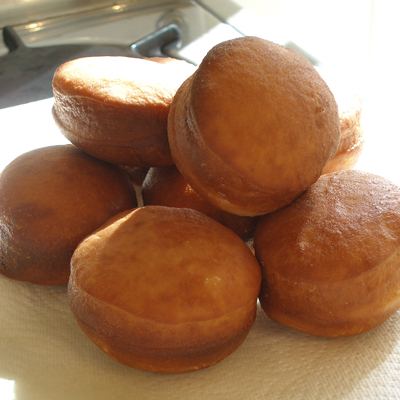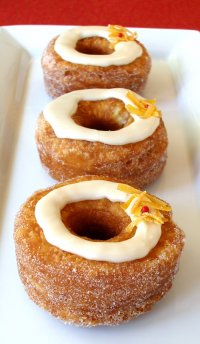 Any food cooked in hot fat is known as fried food. The method is the same whether there's just a little fat in the pan, known as sautéing; the fat comes partway up the sides of the food, called shallow frying; or deep frying is cooking food by submerging it in hot fat.
Any food cooked in hot fat is known as fried food. The method is the same whether there's just a little fat in the pan, known as sautéing; the fat comes partway up the sides of the food, called shallow frying; or deep frying is cooking food by submerging it in hot fat.
Which fats are meant for use in frying?
SARAH SAYS: Liquid and some solid fats can be used for frying. Shortening, lard, and most oils are more suitable for frying, and have a high “smoke point” (the temperature at which the oil starts to smoke and burn). Butter, which has a low smoking point, is not a good choice.
Cooking oils, with a high smoking point, are mild in scent (except for Peanut Oil) and taste neutral:
Canola Oil – neutral flavor and high smoke point
Corn Oil
Grapeseed Oil
Safflower Oil – clean flavor
Sunflower Oil
Pure Vegetable Oil
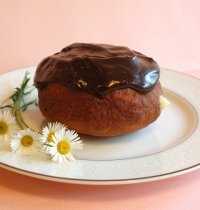 Peanut Oil – imparts the darkest color, giving a slightly nutty taste
Peanut Oil – imparts the darkest color, giving a slightly nutty taste
Olive Oil – Choose a good-quality extra-virgin olive oil that is filtered (solids in greener oils will burn); while its smoke point isn't as high as those of some chemically processed olive oils (whose smoke point can be as high as 460 degrees F). Fry in small batches, since overcrowding the pan can cause the oil's temperature to drop significantly. Deep-frying with olive oil imparts fruity, peppery flavors and creates an incredibly delicate crust.
Vegetable Shortening and Lard:
Both are saturated fats that stay solid at room temperature. Great for deep frying. Lard is great to fry savory foods in where you want its flavor to come through; otherwise, use vegetable shortening. These fats rose to temperature and rebounded between batches more than any of the other fats.
The fat's frying temperature is important
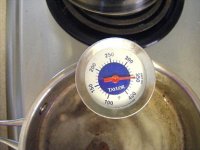 Maintaining the correct and even oil temperature is key to frying. The frying oil's or fat's temperature, usually around 350 degrees F to 375 degrees F, is monitored with a Deep Fry or Candy Thermometer. To maintain an even temperature throughout the cooking process, do not overcrowd the pan, and do allow the temperature to drop slightly when new food is introduced into the pan, which should quickly rise again as the food cooks. Adjust the burner heat during cooking if necessary.
Maintaining the correct and even oil temperature is key to frying. The frying oil's or fat's temperature, usually around 350 degrees F to 375 degrees F, is monitored with a Deep Fry or Candy Thermometer. To maintain an even temperature throughout the cooking process, do not overcrowd the pan, and do allow the temperature to drop slightly when new food is introduced into the pan, which should quickly rise again as the food cooks. Adjust the burner heat during cooking if necessary.
Food will absorb little oil when fried in fat at the right temperature; the fat will produce a crisp exterior and tender interior. If the oil is not hot enough, the food will be soggy because its outside crust forms slowly, allowing the food to absorb more fat and become greasy; if it is too hot, the food will burn on the surface before cooking through.
How frying works:
 When food is added to hot oil, its surface dehydrates. Meanwhile, through a series of Maillard reactions (named after the chemist Louis Camille Maillard), its sugars and proteins break down to create complex flavor and golden-brown color. Browning is quick and thorough because the hot liquid fat delivers heat to even the smallest crevices on a food's surface. In the initial moments of frying, as the surface dehydrates, it forms a crust that inhibits further oil absorption, while continuing to conduct heat to the interior of the food, where the heat causes starches to gelatinize (as in french fries), proteins to denature (in fried chicken), and fibers to soften (in fried zucchini). From Fine Cooking.
When food is added to hot oil, its surface dehydrates. Meanwhile, through a series of Maillard reactions (named after the chemist Louis Camille Maillard), its sugars and proteins break down to create complex flavor and golden-brown color. Browning is quick and thorough because the hot liquid fat delivers heat to even the smallest crevices on a food's surface. In the initial moments of frying, as the surface dehydrates, it forms a crust that inhibits further oil absorption, while continuing to conduct heat to the interior of the food, where the heat causes starches to gelatinize (as in french fries), proteins to denature (in fried chicken), and fibers to soften (in fried zucchini). From Fine Cooking.
Extra tips: Always prepare a paper towel-lined plate or a rimmed baking sheet to drain fried foods and absorb any excess oil; make sure foods are dry before plunging them into the oil to prevent splattering; and never fill the pot or pan more than two-thirds full with oil.
LET'S FRY!
Sautéing:
This how to baking technique is used with the:
 Savory Galette Tutorial, Two Ways – Potato and Caramelized Onion & Tomato and Cheese
Savory Galette Tutorial, Two Ways – Potato and Caramelized Onion & Tomato and Cheese
Sauté and caramelize the onions before use in the recipe:
1. Peel and slice your onion. Cut the onion in half and then lay the onion on the flat side and cut it into thin slices. Set aside.
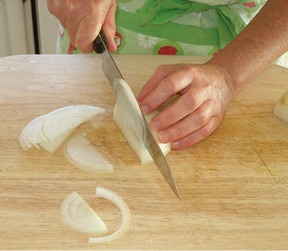
2. Put the 2 teaspoons of olive oil into a large frying pan and add the sliced onions.
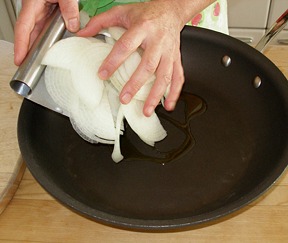
3. Sprinkle the onions with a small pinch of salt and a few grinds of pepper.
4. Start the onions on high heat and cook, stirring occasionally, until they begin to look translucent. You will now begin to caramelize the onions.
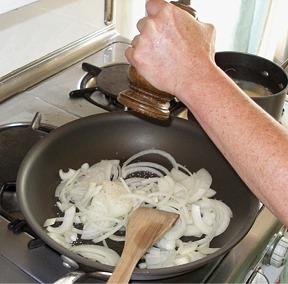
5. When the onions are translucent, turn the heat down to low and cook them, stirring, till they start to turn a lovely golden brown. This takes 10-15 minutes. Do not let them go very long without stirring, or they will burn. Keep and eye on them! Once they burn, they do not taste good!
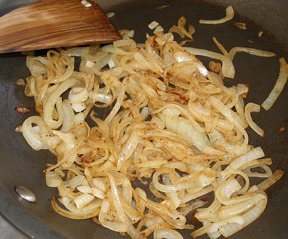
6. Set the onions aside to cool.
Shallow Frying:
This how to baking technique is used with the:
 My Mother's (Priscilla's) Potato Latkes Recipe
My Mother's (Priscilla's) Potato Latkes Recipe
Shallow fry the Potato Latkes before serving:
1. Heat enough peanut oil or Crisco (vegetable shortening) in a skillet to partially submerge latkes by 1/2 to 1 inch. The temperature should reach and remain at 365 – 375 degrees F under medium-high heat. If you don't have a thermometer, oil is ready when you place a small amount of latke batter in it and it sizzles around the edges. Oil should not smoke.
2. Place and carefully flatten 1/8 cup size globs in the hot oil to fry for approximately 5 – 10 minutes. When edges are golden brown, turn over with a slotted spoon and fry on other side for 2 – 3 minutes.
SARAH SAYS: A slotted spoon or spider is useful when transferring fried foods from the pot to the paper towel-lined plate to drain.
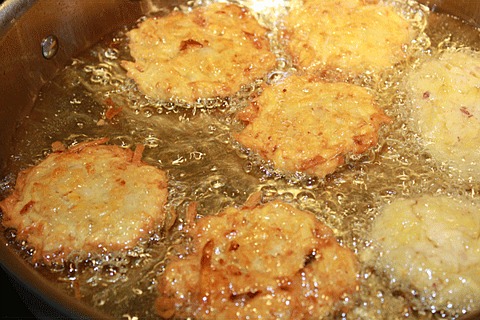
3. Fry to a golden brown if serving right away. If serving later, just fry until very lightly browned. Remove with a slotted spoon to blot and drain on absorbent paper.
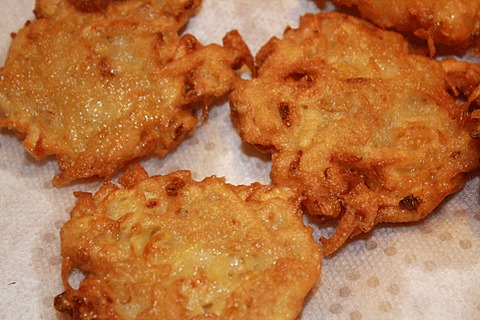
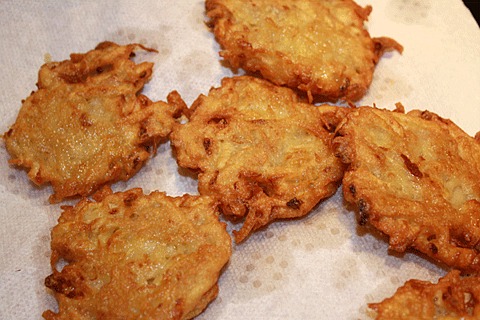
Deep Frying:
This how to baking technique is used with the:
 Bomboloni or Florentine Doughnuts or Donuts Recipe Tutorial
Bomboloni or Florentine Doughnuts or Donuts Recipe Tutorial
Deep Fry the Bomboloni doughnuts:
1. About 20 minutes before using, heat 6 inches (4 to 6 cups) canola oil to 360 degrees F, indicated on a Deep Fry Thermometer, in a large, heavy-bottomed pot.
2. Fry the doughnuts in batches, the same size, 4 or 5 at a time (they will expand as they cook), in the hot oil, gently turning them until they are golden brown on both sides and cooked in the center.
SARAH SAYS: If you fry too many at a time, the oil temperature will dip down too much and they will not fry evenly.
Here we are frying the 1-inch doughnuts.
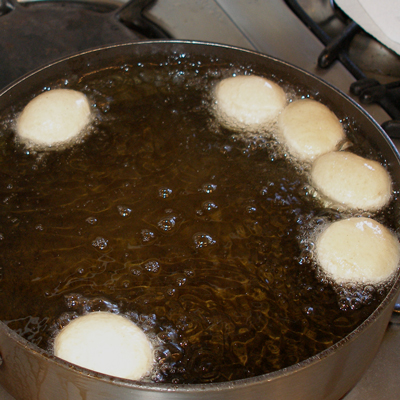
3. Remove the Bomboloni with a large slotted spoon and set on paper towels to drain the excess oil.
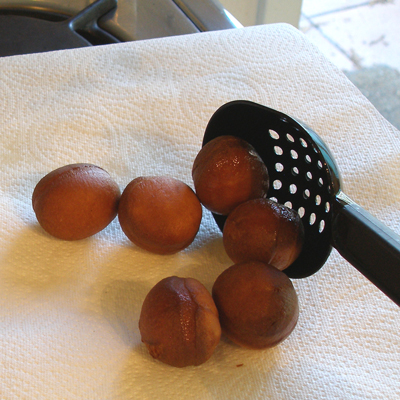
SARAH SAYS: Here we are frying the 2 1/2-inch large size ones together, a few at a time.
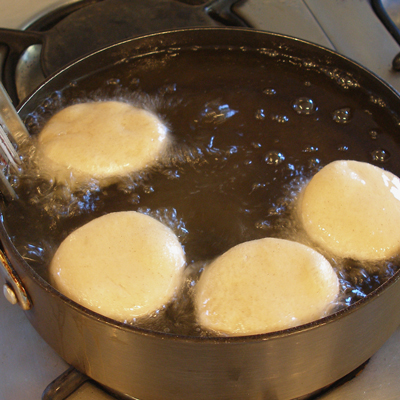
Remove and drain on paper towels when golden brown.
